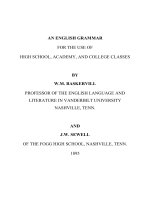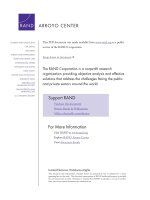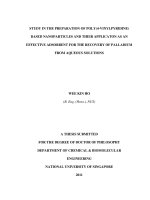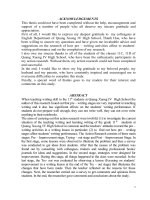An efficient [Bmim]oh catalysed the condensations of aromatic aldehydes and diethyl malonate
Bạn đang xem bản rút gọn của tài liệu. Xem và tải ngay bản đầy đủ của tài liệu tại đây (670.63 KB, 4 trang )
Physical sciences | Chemistry
An efficient [bmim]oh catalysed the condensations
of aromatic aldehydes and diethyl malonate
Thi Thuy Duy Nguyen, Hoang Phuong Tran*
Department of Organic Chemistry, Faculty of Chemistry, University of Science, Vietnam National University, Ho Chi Minh city
Received 12 January 2018; accepted 10 April 2018
Abstract:
Lewis base catalysts such as piperidine, pyridine, NaOH,
K2CO3, etc., which are not recovered and reused [11-14].
Recently, the Knoevenagel reaction using ionic liquids as
catalysts has been studied extensively. The ionic liquid was
one of the most efficient catalytic systems that were easily
recovered and reused several times [15].
The rapid and green procedure for the Knoevenagel
reaction between aromatic aldehydes and diethyl
malonate was developed by using 1-butyl-3methylimidazolium hydroxide, [Bmim]OH, as an
efficient catalyst. The condensations showed good yields
with a wide range of aromatic aldehydes in solvent-free
condition and short reaction times. [Bmim]OH
was easy to recover and could be reused several times
without significant loss of catalytic activity.
In this research, we reported the Knoevenagel
condensations using a basic ionic liquid, [Bmim]OH.
In terms of green chemistry in organic synthesis, we
synthesised [Bmim]OH via the metathesis reaction and
used it as an efficient catalyst for the condensations of
aromatic aldehydes and diethyl malonate under solvent-free
condition. The basic catalyst could be recycled easily by the
extraction and removal of water.
Keywords: green catalyst, green chemistry, ionic liquids,
Knoevenagel reaction.
Classification number: 2.2
Experimental section
Introduction
Ionic liquids are ionic compounds that are liquid below
100°C. Their unique properties include thermal stability,
biodegradability and non-volatility, and they have received
special attention as environmentally benign solvents for
organic synthesis. Ultimately, the combinations of organic
cations and anions help to design and fine-tune their physical
and chemical properties [1-4]. Due to the requirement in
developing the environmentally benign processes, ionic
liquids have been studied intensively as green solvents in
diverse fields such as chemical reactions, electrochemistry
and biochemistry [3, 5-9].
The Knoevenagel condensation reaction, which occurs
between aldehydes or ketones and active methylene
compounds, is a classic method for carbon-carbon bond
formation [2]. The α,β-unsaturated products obtained
by this method has been widely used as intermediates in
organic synthesis and have been found to have increasing
applications in medicine, biological science, agriculture and
light-emitting materials [10]. Unfortunately, this method
needs to be carried out in organic solvents and requires the
All chemicals were purchased from Sigma-Aldrich.
The solvents were supplied by Xilong Chemical. The Agilent 7890A GC-MS system was equipped with a mass
selective detector Agilent 5975N and a capillary column
HP-5MS (length = 30 m, inner diameter = 320 µm, film
thickness = 0.25 µm). The 1H NMR spectra were recorded
on a Bruker 500 MHz using CDCl3 as solvent (Fig. 1).
Br
N
N
Br
N
N
toluen, reflux, 24h
OH
KOH
CH2Cl2, r.t.10h
[Bmim]Br
N
N
[Bmim]OH
Fig. 1. Procedure for the synthesis of [Bmim]OH.
A typical procedure for the synthesis of [Bmim]Br: a
round-bottomed flask (100 mL volume) was charged with
a mixture of 1-methylimidazole (4.10 g, 5 mmol) and
1-bromobutane (6.85 g, 5 mmol) in toluene. Then, it was
placed in an oil bath and heated at 110°C in a magnetic
stirrer for 12 h. After completion the reaction, the reaction
mixture was cooled down to room temperature and then
washed with diethyl ether (3 x 10 mL) to obtain [Bmim]Br
*Corresponding author: Email:
JUne 2018 • Vol.60 Number 2
Vietnam Journal of Science,
Technology and Engineering
3
Physical Sciences | Chemistry
[16]. The purity and authenticity of the ionic liquids were
confirmed by 1H NMR spectroscopy.
1-butyl-3-methylimidazolium bromide [16]: a yellowish
syrup. IR: ν (cm-1): 3098, 2962, 2874, 1631, 1571, 1382,
1168, 1109, 760, 649. 1H NMR (500 MHz, CDCl3) δ 10.29
(s, 1H), 7.53 (t, J = 2 Hz, 1H), 7.42 (t, J = 2 Hz, 1H), 4.30
(t, J = 7.5 Hz, 2H), 4.09 (s, 3H), 1.88 (m, 2H), 1.396-1.321
(sext, J = 7.5 Hz, 2H), 0.93 (t, J = 7.5 Hz, 3H).
A typical procedure for the synthesis of [Bmim]OH:
a mixture of KOH (1.2 g, 20 mmol) and [Bmim]Br (4.4
g, 20 mmol) in dry CH2Cl2 (20 mL) was stirred at room
temperature for 10 h. After the completion of the reaction,
the precipitated KBr was filtered off, and the filtrate was
evaporated under vacuum to obtain the [Bmim]OH as a
viscous liquid. The desired ionic liquid was washed with
diethyl ether (3 × 20 mL) and dried at 90°C for 10 h to
obtain the pure ionic liquid for use [17].
1-butyl-3-methylimidazolium hydroxide [17]: a honeycoloured syrup. IR: ν (cm-1): 3452 (O-H), 3150, 3099, 2962,
2906 (C-H), 1651 (C=N); 1247, 1114, 860. 1H NMR (500
MHz, CDCl3) δ 10.28 (s, 1H), 7.51 (s, 1H), 7.39 (s, 1H),
4.31 (t, J = 7.5 Hz, 2H), 4.09 (s, 3H), 2.32 (bs, 1H), 1.911.85 (m, 2H), 1.37 (dt, J = 15, 7.5 Hz, 2H), 0.94 (t, J = 7.5
Hz, 3H).
A typical procedure for the condensation of
benzaldehyde and diethyl malonate: benzaldehyde (1
mmol), diethyl malonate (1 mmol) and [Bmim]OH (0.3
mmol) were reacted at 100oC for 2 h. After cooling, the
reaction mixture was extracted with diethyl ether (3 x 20
mL). Since [Bmim]OH is insoluble in diethyl ether, it is
easily separated from the mixture. Then, it was washed
in water, which was removed by evaporation. For the
ether layer, it was decanted, washed with water and dried
over Na2SO4. The solvent was then removed by a rotary
evaporator. The desired product was purified by column
chromatography. The purity and authenticity of the product
was confirmed by GC-MS and 1H NMR spectroscopy.
Diethyl benzenlidenemalonate [8]: GC-MS (EI, 80 eV)
m/z 248 (M+). 1H NMR (500 MHz, CDCl3) δ 7.73 (s, 1H),
7.46-7.44 (m, 2H), 7.38-7.36 (m, 3H), 4.35-4.28 (m, 4H),
1.33 (t, J = 7 Hz, 3H), 1.28 (t, J = 7 Hz, 3H). 13C NMR (125
MHz, CDCl3) δ 166.7, 164.1, 142.1, 132.9, 130.5, 129.5,
128.8, 126.4, 61.7, 61.6, 14.1, 13.8.
Results and discussion
We aim to synthesise a ‘green’ catalyst for the
Knoevenagel condensation as well as suggest an efficient
4
Vietnam Journal of Science,
Technology and Engineering
and green process for the synthesis of some functionalised
alkenes that are widely used as intermediates in organic
synthesis.
Preparation and characterisation of catalyst:
[Bmim]Br was synthesised from 1-methylimidazole and
1-bromobutane. Then, [Bmim]OH was obtained by the
metathesis reaction of [Bmim]Br with KOH in dry CH2Cl2.
[Bmim]OH was obtained in high yield and it was applied
as a green basic catalyst for the Knoevenagel condensation.
[Bmim]OH was characterised by FT-IR and H1 NMR
spectroscopy. In the FT-IR spectra of [Bmim]OH, the peak
at 3452 cm-1 is a characteristic of the stretching vibration
of -OH. The peaks at 2900~3000 cm-1 are assigned as the
saturated C-H stretching vibrations. The peaks at 1651
cm-1 could be assigned to the stretching vibration of C=N.
Catalytic testing: the Knoevenagel condensation of
benzaldehyde and dimethyl malonate is used as a model
reaction to investigate reaction conditions in which the
functionalised alkene was obtained in the highest yield and
purity (Fig. 2). All reactions were carried out in an IKA RET
BASIC (USA) heating magnetic stirrer, which is equipped
with an electronic temperature controller.
O
O
H
+
O
EtO
O
[Bmim]OH
OEt
OEt
O
OEt
+ H2 O
Fig. 2. Knoevenagel condensation of benzaldehyde and
dimethyl malonate.
Table 1. The effect of temperature on reaction under
magnetic stirring.
Entry
Temperature (oC)
Yield (%)
1
r.t
13
2
50
54
3
80
76
4
100
95
5
120
99
The condensation between aldehyde and activated
methylene is preferred at high temperature (Table 1). The
temperature of 100oC was chosen as the optimal temperature.
When the temperature was 120oC, the yield of the reaction
slightly increased (Table 1, entries 4-5).
JUne 2018 • Vol.60 Number 2
Yield by GC-MS
80
60
40
20
0
0
2
Non-catalyst
[Bmim]Br
Physical sciences | Chemistry
[Bmim]OH
Catalyst
We applied the optimal conditions for the Knoevenagel
Fig. 3. Control
experiments.
condensation
between some benzaldehyde derivatives and
diethyl
malonate
to study the
of the structural
effect between some
We applied the optimal conditions
foreffects
the Knoevenagel
condensation
of
benzaldehyde
derivatives.
The
results
are
shown
in
the structural e ect of
benzaldehyde derivatives and diethyl malonate to study the e ects of Table
4. derivatives. Theresults are shown in Table 4.
benzaldehyde
Table 2. The effect of the reaction time.
Entry
Time (h)
GC Yield (%)
1
0.5
43
2
1.0
61
3
1.5
84
4
2.0
95
Table 4. The Knoevenagel reaction of different
Table 4. The Knoevenagel reaction of di erent substrates using [Bmim]OH under
substrates using [Bmim]OH under solvent-free.
solvent-free.
As Asthe
reaction time prolonged, the
re was a signi ant increase in the conversion of
the reaction time prolonged, there was a significant
benzaldehyde
The desired
productThe
was
obtainedin quantity (95%) for 2 h (Table 2, entry
increase in the. conversion
of benzaldehyde.
desired
4). product was obtained in quantity (95%) for 2 h (Table 2,
entry 4).
Time (h) Product
Isolated yield (%)
Table
3. The
f the amount of catalyst. Entry Substrate
Table 3. The effect of the amount of catalyst.
Entry
Catalyst (mol%)
1
0
2
5
3
20
4
30
5
40
6
50
1
Yield (%)
Entry
1 0
2 29
3 78
4 91
5
6 92
O
O
Catalyst (mol%)
0
5
2
20
30
40
3
MeO
50
OEt
2
H
Yield (%)
0
O
29 3
H
78
91
O
92H 3
95
O
90
OEt
O
OEt
O
83
OEt
O
OEt 87
MeO
O
OEt
95
O
NO2
O
of the
was was
investigated
on the
OEt
4 on the H
3
67
TheThee effect
ect of
thecatalyst
catalyst
investigated
Knoevenagel
condensation
NO2
Knoevenagel condensation under the current method. The
O
OEt
current
optimal
amount
of the
equiv (Table 3).
optimalmethod.
amount of theThe
catalyst
was only 0.3
equiv. (Table
3). catalyst was only 0.3
under
the
As Asa aresult,
the optimal condition was using 0.3equiv of [B mim]OH and magnetic
result, the optimal condition was using 0.3 equiv
o
5
3
75
C for
2 h.stirring
Additionally,
stirring
at 100and
of [Bmim]OH
magnetic
at 100 C for we
2 h. carried out the control experiments (Fig. 3). No
Additionally,
we carried
the control experiments
(Fig.
desired
product
wasoutobtained
in the absence
of [Bmim]OH.In addition, [Bmim]Br was not
3). No desired product was obtained in the absence of
reactive
in the current method because [Bmim]Br
is a neutral ionic liquid.
[Bmim]OH. In addition, [Bmim]Br was not reactive in the
It is evident that aromatic aldehyde with an electronO
O
H
o
O 2N
current method because [Bmim]Br is a neutral ionic liquid.
91
Yield by GC-MS
100
80
60
40
20
0
0
2
Non-catalyst
[Bmim]Br
Catalyst
Fig. 3. Control experiments.
[Bmim]OH
OEt
O 2N
O
OEt
donating group such as 4-methylbenzaldehyde and
4-methoxybenzaldehyde was less reactive than
benzaldehyde, by 83% and 77%, respectively (Table 4,
entries 2, 3). The desired products were obtained in lower
yields with nitrobenzaldehydes because these substrates
were less soluble in the reaction mixture (Table 4, entries
4, 5). In addition, 2-nitrobenzaldehyde reacted at lower
conversion (Table 4, entry 4) due to the increased steric
hindrance of ortho-substitution.
The [Bmim]OH catalyst was easily recovered and
reused without any loss of catalytic activity. Since [Bmim]
OH is insoluble in diethyl ether, it is easily separated from
the mixture. Then, it was washed and dried under vacuum.
Fig. 3. Control experiments.
Vietnam Journal of Science,
JUne
2018 Knoevenagel
• Vol.60 Number 2 condensation between
5
We applied the optimal conditions for
the
some
Technology and Engineering
benzaldehyde derivatives and diethyl malonate to study the e ects of the structural e ect of
Physical Sciences | Chemistry
The recovered [Bmim]OH was reactive in the Knoevenagel
condensation of benzaldehyde, and dimethyl malonate
produced the desired product in 89% isolated yield.
Conclusions
To conclude, the basic ionic liquid [Bmim]OH is an
efficient catalyst for the Knoevenagel condensation. The
ionic liquid is known as green solvent/catalyst for many
organic transformations. These condensations of aromatic
aldehydes and diethyl malonate were efficiently catalysed
by a small amount of [Bmim]OH under a solvent-free
condition with high reaction yields in short reaction times.
ACKNOWLEDGEMENTS
This research is funded by Vietnam National University,
Ho Chi Minh city (VNU-HCM) under grant number 5622018-18-03.
REFERENCES
[1] P. Moriel, E.J. García-Suárez, M. Martínez, A.B. García, M.A.
Montes-Morán, V. Calvino-Casilda, M.A. Banares (2010), “Synthesis,
characterization, and catalytic activity of ionic liquids based on
biosources”, Tetrahedron Lett., 51(73), pp.4877-4881.
[2] M.B. Smith, J. March (2001), March’s advanced organic
chemistry: reactions, mechanisms, and structure, John Wiley & Sons.
[3] T. Welton (1999), “Room-temperature ionic liquids. Solvents for
synthesis and catalysis”, Chem. Rev., 99(8), pp.2071-2083.
[4] P.H. Tran, X.T.T. Nguyen, D.K.N. Chau (2018), “Brønsted-acidic
ionic liquid gel as an efficient and recyclable heterogeneous catalyst for
the synthesis of bis(indolyl)methanes under solvent-free sonication”,
Asian J. Org. Chem., 7, pp.232-239.
[5] J. Safari, Z. Zarnegar (2013), “Immobilized ionic liquid on
superparamagnetic nanoparticles as an effective catalyst for the synthesis
of tetrasubstituted imidazoles under solvent-free conditions and
microwave irradiation”, Comptes Rendus Chim., 16(10), pp.920-928.
[6] S.P. Borikar, T. Daniel (2011), “A convenient and efficient protocol
for the synthesis of acylals catalyzed by Bronsted acidic ionic liquids
under ultrasonic irradiation”, Ultrason. Sonochem., 18(5), pp.928-931.
6
Vietnam Journal of Science,
Technology and Engineering
[7] J.R. Harjani, S.J. Nara, M.M. Salunkhe (2002), “Lewis acidic
ionic liquids for the synthesis of electrophilic alkenes via the Knoevenagel
condensation”, Tetrahedron Lett., 43(6), pp.1127-1130.
[8] G.H. Gao, L.U. Liang, et al. (2007), “Basic ionic liquid: a reusable
catalyst for knoevenagel condensation in aqueous media”, Chemical
Research in Chinese Universities, 23(2), pp.169-172.
[9] A.R. Hajipour (2009), “Basic ionic liquids. A short review”, Rev.
Lit. Arts Am., 6(4), pp.647-678.
[10] M. Zahouily, M. Salah, B. Bahlaouane, A. Rayadh (2004),
“Solid catalysts for the production of fine chemicals: the use of natural
phosphate alone and doped base catalysts for the synthesis of unsaturated
arylsulfones”, Tetrahedron, 60(7), pp.1631-1635.
[11] Yi-Qun Li (2000), “Potassium phosphate as a catalyst for the
Knoevenagel condensation”, Journal of Chemical Research, 2000(11),
pp.524-525.
[12] S. Zhao, X. Wang, L. Zhang (2013), “Rapid and efficient
Knoevenagel condensation catalyzed by a novel protic ionic liquid under
ultrasonic irradiation”, RSC Adv., 3(29), pp.11691-11696.
[13] M.R. Poor Heravi, S. Piri (2012), “Efficient Knoevenagel
condensation reactions catalyzed by activated gel zirconium(IV) oxide”,
J. Chem., 2013, pp.1-5.
[14] A. McCluskey, P.J. Robinson, T. Hill, J.L. Scott, J.K. Edwards
(2002), “Green chemistry approaches to the Knoevenagel condensation:
comparison of ethanol, water and solvent free (dry grind) approaches”,
Tetrahedron Lett., 43(17), pp.3117-3120.
[15] D.C. Forbes, A.M. Law, D.W. Morrison (2006), “The
Knoevenagel reaction: analysis and recycling of the ionic liquid medium”,
Tetrahedron Lett., 47(11), pp.1699-1703.
[16] P.N. Tshibangu, S.N. Ndwandwe, E.D. Dikio (2011), “Density,
viscosity and conductivity study of 1-butyl-3-methylimidazolium
bromide”, Int. J. Electrochem. Sci, 6(6), pp.2201-2213.
[17] B.C. Ranu, S. Banerjee (2005), “Ionic liquid as catalyst and
reaction medium. The dramatic influence of a task-specific ionic liquid,
[Bmim]OH, in Michael addition of active methylene compounds to
conjugated ketones, carboxylic esters, and nitriles”, Org. Lett., 7(14),
pp.3049-3052.
JUne 2018 • Vol.60 Number 2









